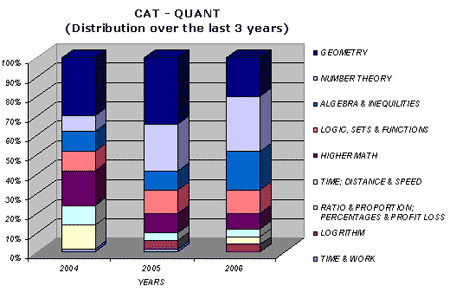|
|
| Help | |
| You are here: Rediff Home » India » Get Ahead » Careers » Cracking CAT |
|
| |||||||||||||||||||||||
|
| |||||||||||||||||||||||
Attention, CAT aspirants:
You have less than three months to prepare and 2,00,000 strong competitors staring you in the face!
Do you have jitters yet? If not, you should.
By now, most CAT aspirants have completed their basic preparation. In this phase, students' scores in the half-length tests behave like the volatile Sensex -- unpredictably. So, if you think group meetings and loads of testing is all you need to continue improving your scores -- sorry, you're wrong. For the final few months, you should revise and review your study plan.
At this point, the strategic approach of a general is what you need, not merely a soldier's aggression. You must plan, execute, evaluate and revise. If you don't prepare properly, your percentile will decrease markedly by C-day.
Here's a plan of action for the final, a strategy for the final ten weeks of CAT 2007 preparation.
A factual, exhaustive and balanced study plan must have both micro as well as macro facets to it.
The micro aspect involves the day-to-day planning and subsequent execution of these points. This allows you to keep a consistent, steady tempo and pace to your preparation.
A micro view of CAT preparation
Your plan should be prepared and executed on daily basis. An example can be -- two hours on number theory, one hour on
Give simple, straight-forward descriptions of your daily tasks. Complicated or confusing directions will just leave you lost and discouraged.
Unlike your old and memorable Class X board exam preparation, you need to follow many books rather than concentrating on one or two. CAT has more and more questions from fewer and fewer topics. Hence the key is to exercise your skills on those VITAL topics from as many sources as possible.
All three sections -- quantitative, data interpretation and verbal -- must be touched every day. This will help you exercise discipline and will ensure that you devote equal time to each of them. Moreover, such a study plan gives a sense of completeness to your preparation on a daily basis and keeps your confidence and achievement levels up.
Every set of sectional preparation must be followed by an assessment (testing) of the same. So always keep one series of tests for the evaluation of each step of your micro preparation. An additional weekly combined test would be even better.
In the end comes another very important step: evaluation and analysis. All the tests taken must be evaluated properly and analysed. If possible, have a record on a spreadsheet of all the tests that you take.
In order to learn how to critically analyse your tests, register at www.tcyonline.com to attempt online MBA tests and see the analysis page at the end of each test. Such analysis will shed light on your strengths and weaknesses, helping you concentrate on where you need to improve.
But sticking to such a frequently updating plan may cause your overall preparation to move slowly. This may subsequently result in missing certain topics all together, or losing sight of the 'big picture.' Hence, a micro plan must stick to an overall macro plan.
A macro view of CAT preparation
Your macro plan should be consolidated and divided into weekly or fortnightly segments. An example:
In the next two weeks: Complete number theory, algebra and geometry from quantitative; practice at least 35 to 40 reading comprehension questions, 200 gap fills and 200 English usage exercises from the verbal section; practice approximately 400 data interpretation questions.
Use weekends to manoeuvre the pace of your micro preparation to match the macro milestones. Macro planning must be done by working backwards from
The milestones in the macro plan must be planned on the lines of mock CATs (specifically National level CATs). It is a good idea to appear in at least (if not all because of time constraint) two mock CATs conducted by institutes other than yours. This helps a test-taker in developing a more objective understanding of his performance vis-�-vis others.
Which areas deserve the most focus?
If you look at and analyse the actual CATs from 2004, 2005 and 2006, you can prepare a factual and accurate list of topics to be covered.


++ Data: Previous year CATs
** Analysis: Top Careers & You
As the above two charts show, the share of number theory in quantitative and that of reading comprehension in verbal is increasing. Your study plan must be structured around exercising the most frequently asked topics in the CAT -- hence, you should focus on these two areas. This will help you cover the most important topics first, moving down the areas in the decreasing order of their probability to appear on the exam.
Here's another informative chart, where we have summarised the contribution of the various sub-sections of quantitative and verbal sections in the total CAT:


++ Data: Previous year CATs
** Analysis: Top Careers & You
It is quite obvious from the above two pie-charts that reading comprehension in verbal and geometry and number theory in quantitative have clean pre-eminence over the other sub-section in previous. On the other hand, vocabulary and paragraph jumbles in verbal and time and work, ratio and proportion, and profit-loss sections made negligible contributions to the previous CATs.
Use this information to thoroughly cover the most important topics while spending less time on the least important -- this will help you increase your overall score.
Accuracy and speed: the perfect mixture
Remember that the CAT is not about solving 75 questions in 150 minutes. It is about solving 45 to 55 questions with 85 to 90 percent accuracy. Hence, attempting all the questions is not the mark of your achievement in CAT.
Accuracy is a distinguishing factor among the test-takers. But focusing on accuracy alone may lead to spending more than average time on the questions, which could cause panic towards the end of the exam. Therefore, an optimum mix of both accuracy and speed is desired.
Here are a few ways you can achieve an optimum combination of accuracy and speed before November 18:
- Strictly follow a preparation schedule in order to eliminate the possibility of stress and pressure near November 10 and 15 that otherwise arises because of pending examination.
- Keep a track record of your performance in terms of your total attempt together with percentage accuracy.
- Rank yourself on the above two parameters compared to classmates and other peers.
In the end, always keep in mind that clarity of your strategy and clarity of your goals will help you stay focused during these final months of CAT preparation.
|
|
| © 2007 Rediff.com India Limited. All Rights Reserved. Disclaimer | Feedback |